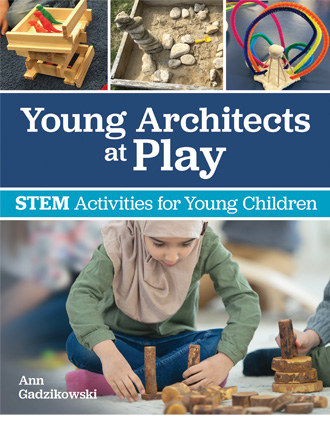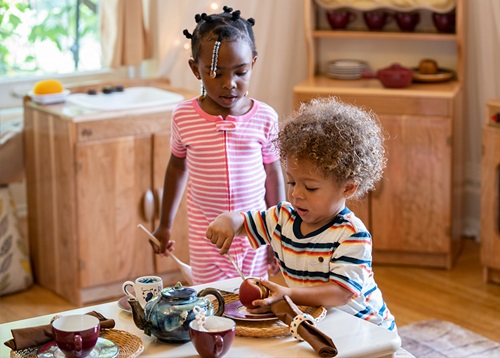Young Architects at Play
Helping young children construct their knowledge of the world.
| June 2021What Is Architecture?
As an early childhood educator, I am fascinated by children’s construction play. Children seem to universally enjoy building, whether with natural objects, blocks, or other materials. I have a deep appreciation for how it allows children to develop cognitive skills, express creativity, and add complex layers of story and meaning.
In my work with children and teachers, I’ve found that architecture is the bridge that connects these ideas. Architecture is the art, science, and process of planning, designing, and constructing buildings. The word architecture can refer to this process as well as the buildings that result from it.
We often associate architecture with famous architects and complex buildings and structures. But architecture gives us vocabulary to talk about the buildings and structures all around us. You likely have a roof over your head right now as you read this page of words. Understanding architecture helps us better notice what architects call “the built environment”: houses, apartment buildings, and other structures as well as roads and bridges.
As you will discover, architecture also gives us examples, both real and imagined, that inspire and provoke exciting construction projects in early childhood classrooms. As a teacher, I believe thinking and learning about architecture has significantly enhanced my ability to support children’s construction play and deepen their learning experiences.
Architecture and Children
The child who pokes sticks in the dirt and builds a home for her rock is an architect. Every child who constructs a house out of sticks or stones or blocks or LEGO is an architect. Architecture is demonstrated every day in children’s play across the globe. So why don’t we see the topic of architecture included in early childhood education? Why is it almost invisible when it comes to how and what children learn?
We usually only find courses and curriculum bearing the title of “Architecture” at the college level. And out of the 1.5 million bibliographic records in the Educational Resources Information Center, only two records are related to teaching young children about architecture. Both involve projects with school- age children (kindergarten through grade five) (Hollingsworth, 1993; Luera and Hong, 2003). There are zero articles documenting any connection between the topic of architecture and children five and younger.
It seems that architecture is not intended for children. However, young children usually already have an intuitive sense of architecture. More simply, they understand that every building has a purpose. They understand that homes are built to provide shelter. Schools are built so we can come together and learn. Stores are built so people can buy food and other things they need. And hospitals are built so we can take care of people who are hurt or ill. Children realize there is a clear sense of purpose in the various buildings and structures in our communities—a sense that form follows function.
Therefore, there are many developmentally appropriate ways that the study of architecture can begin in early childhood. For example, children may look at pictures of different kinds of buildings, visit buildings in their neighborhoods, and talk about why and how we build. In turn these architecture-related activities can inspire children to develop new ideas through block and construction play. Talking and thinking about architectural features, such as doors and windows, can also add complexity and interest to children’s construction projects.
Constructivism and Architecture
Constructivism is a theory of cognitive development. It is centered on the idea that children learn through direct physical experience, through play, and through their interactions with their environment. This approach to early learning, as articulated by theorists Jean Piaget and Lev Vygotsky, emphasizes the importance of children’s physical, sensory experiences with the world around them. No doubt construction play is a true form of constructivist learning. Whether with blocks, toys, or other materials, construction play is at the core of developmentally appropriate practice.
As a constructivist early childhood educator, I believe architecture provides an important connection bridging young children’s play to the real-world skills and knowledge they will develop as productive adults. Architecture engages all four STEM content areas: science, technology, engineering, and math.
Construction play and architecture-inspired activities also develop important spatial skills. This is especially true when children represent their ideas using three-dimensional tools (blocks, loose parts, and construction toys) as well as two-dimensional tools (drawing, writing, and mapping). At the same time, architecture also provides opportunities for creative and artistic expression, language development, and literacy development. Ludwig Mies van der Rohe, the German American regarded as a pioneer of modernist architecture, is credited with asserting that “architecture is a language” (Domus, 2016).
This phrase calls to mind the words of Loris Malaguzzi, founder of the renowned infant-toddler centers and preschools of Reggio Emilia, Italy. Malaguzzi explored the concept of “the hundred languages of children.” He wrote, “The child has a hundred languages, a hundred thoughts, a hundred ways of thinking, of playing, of speaking. A hundred, always a hundred ways of listening, of marveling, of loving, a hundred joys, for singing, for understanding, a hundred worlds to discover, a hundred worlds to invent, a hundred worlds to dream” (Malaguzzi, 1993, 3).
It’s highly unlikely that van der Rohe and Malaguzzi ever met, yet their ideas beautifully align. Architecture is indeed a language—one of the hundred children use to express themselves. This language can be artfully expressed even on a small scale, as represented in construction play and architecture explorations in the preschool classroom.
Benefits of Architectural Play
Simply put, architectural play supports children’s capacity to learn. Here’s how open-ended and creative architectural play experiences support healthy brain development:
- Construction play is meaningful. When children build freely from their own imagination, creating houses and other structures, they connect their prior knowledge with new inventions and experiences. Making meaningful connections stimulates networks in the brain associated with logical thinking, metacognition, and creativity.
- Construction play is actively engaging. The physical tasks associated with construction play—such as lifting, stacking, and balancing—activate areas of the brain associated with decision-making, executive function, and self-regulation.
- Construction play is iterative. An iterative process is one that involves repetition, experimentation, and exploration. During construction play, towers fall, roofs cave in, and walls tumble. Most children are eager to try and try again until they find success. The perseverance demonstrated during construction play engages neural networks that are associated with flexible thinking and creativity.
- Construction play is socially interactive. In most early childhood classrooms, construction play takes place in pairs and small groups. Collaboration and conversation promote plasticity in the brain that helps children develop empathy and social skills.
- Construction play is joyful. The block corner is often the loudest area of the classroom—and for good reason. Joy is noisy. The excitement of building with blocks or any material makes children laugh and call out to each other with joy. This sets the stage for a lifetime of health and well-being, as joy is associated with chemicals that are linked to enhanced memory, attention, and motivation, such as dopamine.
From Young Architects at Play: STEM Activities for Young Children by Ann Gadzikowski. Copyright 2020 by Ann Gadzikowski. Reprinted with permission from Redleaf Press.
Read the book:











